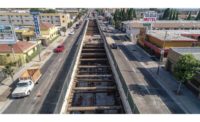Technology
How AR Could Change Train Dispatching and the Design of Rail System Control Centers
Engineer Ross & Baruzzini Macro is testing an augmented reality train dispatching system that could eliminate hardware


In transit control centers, dispatchers rely on multi-monitor displays and video walls as they manage the movement of trains traversing the nation’s rail systems.
This universal technology infrastructure has guided the design of these mission-critical facilities since transit agencies initially transitioned from mechanical “model board” track layouts to digital displays in the early 1980s. A new study led by Ross & Baruzzini Macro is examining whether augmented reality might inspire a more flexible, space-efficient model for the next generation of transit control center facilities.
Underwritten by a $100,000 grant from the Transportation Research Board, the program involves developing and testing the viability of an AR train dispatcher interface as an effective replacement for the costly console display monitors and video walls.
A World Without Walls
The research team collaborated with partners from the Utah Transit Authority (UTA) to identify and define the functional requirements for an AR display. The resulting proof-of-concept interface, built by AR software developer 360world, combines the Microsoft HoloLens wearable headset with an open-source train dispatching simulator and a modified version of Clairity, a mixed-reality platform developed for air traffic control.
The new interface is not intended to replace existing train control software, but has been developed as a “middleware” solution that takes the data and information from an existing train control system and adapts it to an AR environment.
As envisioned, the concept will enable transit dispatchers to have continuous access to real-time 3D track layout and train movement as well as the ability to view schedule adherence and information about services and stations. Essentially, dispatchers will be able to perform all of their existing duties without the need to interact with physical monitors or video walls. The idea is that the visibility of a track layout won’t be restricted by the size of a monitor or other hardware limitations.
Because the layout and orientation of AR displays are controlled by software rather than hardware, each user can customize their “workspace” without being constrained by the size and placement of physical monitors. Since the AR interface isn’t tethered to a fixed location, it also opens up the possibility of dispatchers doing their jobs remotely, a practical scenario in an era of social distancing.
The concept has enormous potential implications for the design, construction and operation of future transit control centers. Replacing fixed console display monitors and giant video walls with mobile AR devices would decrease space requirements, simplify IT infrastructure and significantly reduce an agency’s ongoing costs.
It also would expand architectural design options by eliminating the need to plan a control theater space with a tiered floor and raised ceilings to ensure that all dispatchers have a proper sightline to the video wall.
It could also increase the flexibility of constructing and operating backup control centers, which maintain business continuity if the primary facility becomes non-functional or inaccessible. Because an AR control theater requires no on-desk hardware, a back-up control center space could potentially function as a training or meeting room when it isn’t being engaged as a control center.
Testing the Technology
To test the AR interface with potential users, Ross & Baruzzini Macro is currently conducting on-site pilot testing with a group of UTA train dispatchers and managers. During this field-testing phase, users wear the AR train dispatcher interface loaded with a portion of their system’s track line to simulate the view they experience in their day-to-day jobs. They also learn how to manage the movement of trains using a wide variety of hand gestures, arm movements and voice commands.
After the test, each dispatcher completes a user survey about their overall experience. The results of this questionnaire helps to identify opportunities to refine the interface and improve the user experience. Feedback will also uncover potential barriers to more widespread adoption of AR technology within transit control centers.
This fall, the Ross & Baruzzini Macro team is expected to deliver a comprehensive report detailing lessons learned from the project and assessing the viability of AR for train dispatching and other control center functions. The findings won’t be directly connected to the development of a new commercial product or technology, but rather, they’re intended to serve as a springboard to additional discussion and innovation within the industry.
Ideally, this study will inspire transit agencies, current train control vendors and AR vendors from outside the industry to seriously consider how AR and other advanced technology can shape the next generation of control center facilities. In an age when crowding around a video wall is suddenly out of fashion, it may be coming exactly when the industry needs it.
Megan Huff is vice president and managing principal, mobility systems and communications, at Ross & Baruzzini Macro in Lansdale, Pa.


